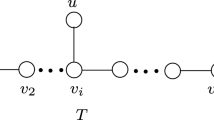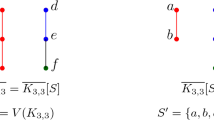Abstract
A problem concerning packet switched networks leads to a natural combinatorial design problem, whose solution involves (k, n)-arcs in projective planes, 3-dimensional linear codes, the theory of fractional matchings and designs which approximate projective planes.
Similar content being viewed by others
References
J. C. Bermond, J. Bond, M. Paoli and C. Peyrat, Graphs and interconnecting networks: diameter and vulnerability, In (E. K. Lloyd, ed.), Surveys in Combinatorics, Cambridge Univ. Press (1983) pp. 1–30.
A. Blokhuis, D. Jungnickel and B. Schmidt, On a class of symmetric divisible designs which are almost projective planes, In (A. Blokhuis, J. W. P. Hirschfeld, D. Jungnickel, J. A. Thas, eds.) Finite Geometries Kluwer (2001) pp. 27–34.
R. C. Bose and W. S. Connor, Combinatorial properties of group divisible incomplete block designs, Ann. Math. Statistics, Vol. 23 (1952) pp. 367–383.
R. C. Bose, S. S. Shrikhande and K. N. Bhattacharya, On the construction of group divisible incomplete block designs, Annals of Mathematical Statistics, Vol. 24 (1953) pp. 167–195.
C. J. Colbourn, Projective planes and congestion-free networks, Discrete Applied Mathematics, Vol. 122 (2002) pp. 117–126.
C. J. Colbourn, J. H. Dinitz and D. R. Stinson, Applications of combinatorial designs to communications, cryptography and networking, In Surveys in Combinatorics 1999, Cambridge University Press (1999) pp. 37–100 (1999 British Combinatorial Conference).
P. Dembowski, Finite Geometries, Springer (1968).
Z. Füredi, Maximum degree and fractional matchings in uniform hypergraphs, Combinatorica, Vol. 6 (1981) pp. 155–162.
Z. Füredi, Covering the complete graph by partitions, Discrete Mathematics, Vol. 75 (1989) pp. 217–226.
J. H. Griesmer, A bound for error-correcting codes, IBM Journal Research Development, Vol. 4 (1960) pp. 532–542.
N. Hamada and F. Tamari, Construction of optimal codes and optimal fractional factorial designs using linear programming, Annals of Discrete Mathematics, Vol. 6 (1980) pp. 175–188.
G. Solomon and J. J. Stiffler, Algebraically punctured cyclic codes, Information and Control, Vol. 8 (1965) pp. 170–179.
D. Wiedemann, Cyclic difference covers through 133, Congressus Numerantium, Vol. 90 (1992) pp. 181–185.
B. Yener, Y. Ofek and M. Yung, Combinatorial design of congestion-free networks, IEEE/ACM Trans. Networking, Vol. 5 (1997) pp. 989–1000.
Author information
Authors and Affiliations
Rights and permissions
About this article
Cite this article
Bierbrauer, J., Marcugini, S. & Pambianco, F. Projective Planes, Coverings and a Network Problem. Designs, Codes and Cryptography 29, 71–89 (2003). https://doi.org/10.1023/A:1024140122167
Issue Date:
DOI: https://doi.org/10.1023/A:1024140122167




